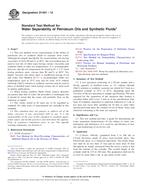We need your consent to use the individual data so that you can see information about your interests, among other things. Click "OK" to give your consent.
ASTM D1401-12
Standard Test Method for Water Separability of Petroleum Oils and Synthetic Fluids
STANDARD published on 15.5.2012
The information about the standard:
Designation standards: ASTM D1401-12
Note: WITHDRAWN
Publication date standards: 15.5.2012
SKU: NS-17173
The number of pages: 5
Approximate weight : 15 g (0.03 lbs)
Country: American technical standard
Category: Technical standards ASTM
Annotation of standard text ASTM D1401-12 :
Keywords:
emulsion, petroleum oils, steam-turbine oils, synthetic fluids, water separability, ICS Number Code 75.040 (Crude petroleum), 75.120 (Hydraulic fluids)
Additional information
| Significance and Use | ||||||||||
|
This test method provides a guide for determining the water separation characteristics of oils subject to water contamination and turbulence. It is used for specification of new oils and monitoring of in-service oils. |
||||||||||
| 1. Scope | ||||||||||
|
1.1 This test method covers measurement of the ability of petroleum oils or synthetic fluids to separate from water. Although developed specifically for steam-turbine oils having viscosities of 28.8–90 mm2/s at 40°C, this test method may be used to test oils of other types having various viscosities and synthetic fluids at other test temperatures. It is recommended, however, that the test temperature be raised to 82 ± 1°C when testing products more viscous than 90 mm2/s at 40°C. For higher viscosity oils where there is insufficient mixing of oil and water, Test Method D2711 is recommended. Other test temperatures such as 25°C may also be used. A1% sodium choloride (NaCl) solution or synthetic seawater may be used in place of distilled water when testing certain oils or fuels used in marine applications. 1.2 When testing synthetic fluids whose relative densities are greater than that of water, the procedure is unchanged, but it should be noted that the water will probably float on the emulsion or liquid. 1.3 The values stated in SI units are to be regarded as standard. No other units of measurement are included in this standard. 1.4 This standard does not purport to address all of the safety concerns, if any, associated with its use. It is the responsibility of the user of this standard to establish appropriate safety and health practices and determine the applicability of regulatory limitations prior to use. For specific warning statements, see Section 6. |
||||||||||
| 2. Referenced Documents | ||||||||||
|
We recommend:
Technical standards updating
Do you want to make sure you use only the valid technical standards?
We can offer you a solution which will provide you a monthly overview concerning the updating of standards which you use.
Would you like to know more? Look at this page.




 Cookies
Cookies
